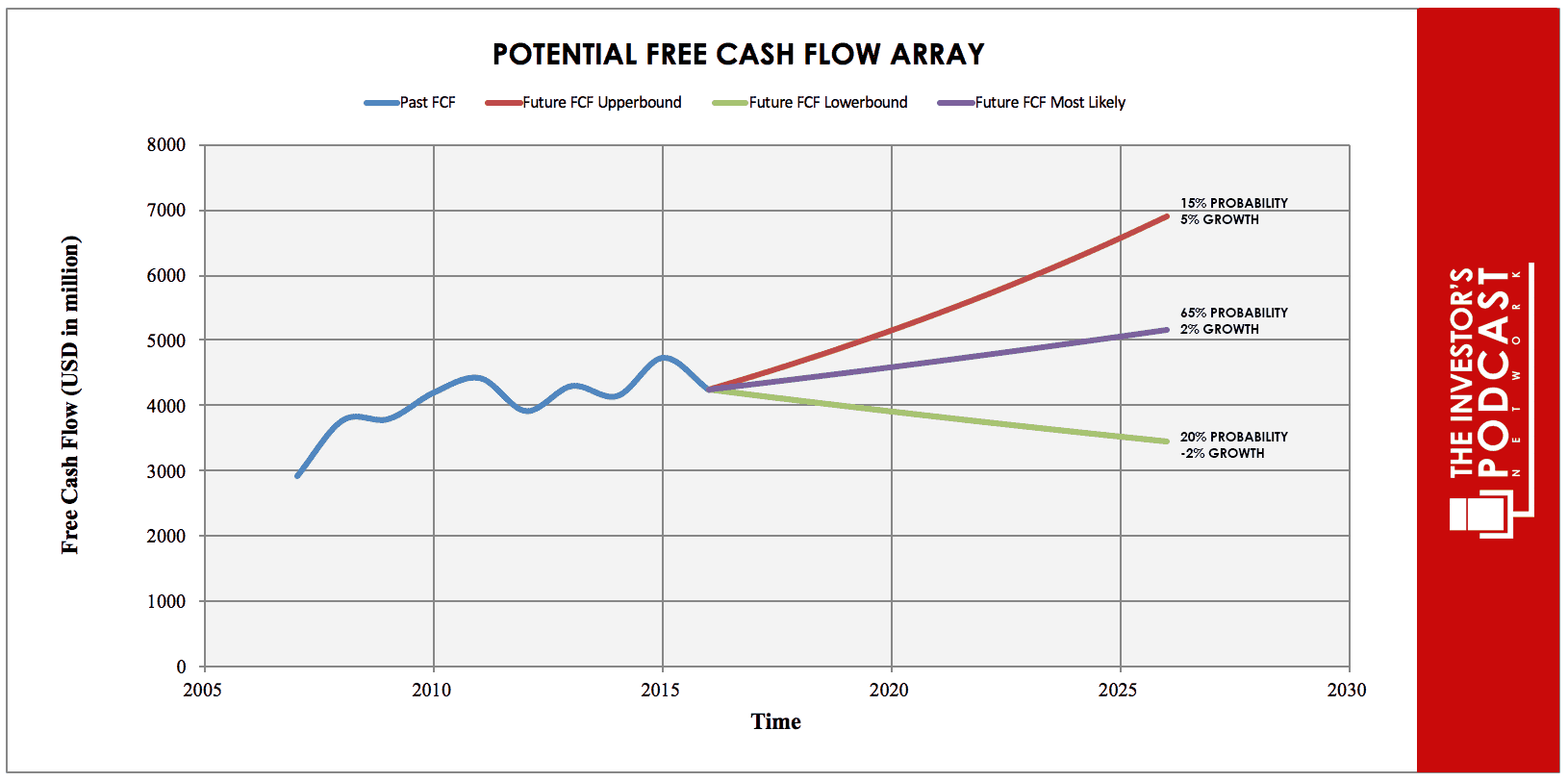Intrinsic Value Assessment Of McDonald’s (MCD)
By Eoin O’Byrne From The Investor’s Podcast Network | 09 October 2017
INTRODUCTION
McDonald’s is an employer of 350,000 people and serves 68 million people daily across 119 countries. These restaurants are either owned by McDonald’s or are franchised restaurants; this can be both positive and negative to the Golden Arches brand as we explore later.

Franchising is responsible for operating over 80% of the branches and is, therefore, creating a strong flow of capital for the corporation. As McDonald’s owns all of the lands on which the restaurants are established, it has a vast real estate empire and this, married with co-investment from franchisees, has led to one of the most successful franchises in the world economy. In 2014, of the total $1.2trillion in sales generated by all the worlds ‘Informal Eating Out’ (IEO) Segment, McDonald’s, which accounts for 0.5% of all IEO’s globally, generated 7.2% of sales.
When this sector is expanded to include all restaurants, McDonald’s market presence is 0.2%, and yet it accounts for 3.6% of sales in the market of $2.4 trillion sales. As we can see from the above performance, McDonald’s is a significant fixture in the global eatery marketplace.
MCDONALD’S INTRINSIC VALUE
McDonald’s has a consistent free cash flow which allows high ranking members of the corporation to reinvest the money into the company through expansion into other marketplaces. As we can see, the FCF has grown 70% of the time over the last decade. This indicates that the company has been run with controlled spending and positive income flows generated from its franchise income. We like to see this level of continued FCF growth as it shows a competent management is in place and can control both the inflows and outflows of the corporation.

Below, we can see the 10-year projected free cash flow for McDonald’s with three projected future FCF bands containing an Upper (5% growth), Middle (2% growth), and Lower (-2% growth). I selected the upper band by judging the size of the company and how much potential for growth there is. With the company being so globalized, there is little room for expansion. Therefore, the level of growth achieved is unlikely to grow at any significant rates or even more significant than it has over the past decade which has been 4.5%. The middle band was selected on a similar principle to the upper band; about such past levels of growth being improbable to replicate. The lower band uses negative growth also at such a low level in spite of the company’s lack of room to expand as it receives such a healthy stipend through franchise revenue. The IRR which will be generated based on my calculations will be 1.3% this level of return is in line with the yield on US T-Bills which once factored for inflation generates just below 1%.

The level of dividends payments over the last decade have been between $2 and $4 a share. This payout ratio for these dividends has been quite high over the last few years between 60-70%. This level of payout is large and is something which the company can keep providing as they are more than likely not going to expand over the foreseeable future.
Also, any repercussions in reducing the dividend will greatly outweigh any minimal growth achieved by expansion. This level of payment may be due to the low levels of return otherwise generated by the stock and is the company’s way of rewarding stockholders.
MCDONALD’S COMPETITIVE ADVANTAGE
A major moat that McDonald’s possesses is its name; the name is synonymous with tasty fast food and good times. This idea is most noted in the “Happy Meal” – a child’s meal that comes with a toy and is the highlight of many children’s outings and adult’s childhood memories. McDonald’s keeps this nostalgic and family element of the franchise throughout the majority of marketing campaigns and food offerings, while always projecting that image and association with the McDonald’s name. This one option on the McDonald’s menu accounts for just under 15% of all orders in the restaurant and is responsible for generating $10,000,000 daily for the corporation worldwide.
As mentioned in the intrinsic value section of this analysis, McDonald’s has been paying quite a high amount of dividends. This 40-year history of paying a dividend shows that the company has the means and the wherewithal to continue paying as the company generates its significant income through steady franchising channels. This is noted in the company’s high coverage ratio which currently stands at 9.94. This ratio indicates the ability of the company to service its debt. Currently, McDonald’s has an operating income of $2,295 million, and their Interest Expense resides presently at -$231 million.
Small Top 5 ownership stake at 7.8% means no individual stockholder is exerting undue influence and power to block the company from taking actions which the shareholder may not want as it does not generate short-term rewards. The franchise model generates positive cash inflows. This level of steady revenue generated through a minimal effort by the McDonald’s Corporation through its franchisees is not matched by any other competitor. More so, the 80% of McDonalds’ restaurants are franchises, and these restaurants pay an initial fee of $45,000 as well as 4% annually on profits. This continuous positive cash flow is essential to the corporation’s profitability.
RISKS
A negative health image and food safety concerns are two of the major issues outlined in McDonald’s 10K filings. This association with fast food and an unhealthy lifestyle may be dangerous for the company as fewer people may visit a McDonald’s location and, instead, opt for healthier options like juice bars. McDonald’s has tried to better their menus by offering salads and providing fruit snacks inside children’s Happy Meals. The current phenomenon developed by millennials to create food trends through social media has been noted by many brands and has caused companies to react quickly by adapting and reinventing products to meet ever-changing consumer demands while trying to avoid losses. This change in trend is something McDonald’s needs to be ever vigilant of and adapt where necessary.
Although the franchise model does work for them, it can cause significant headaches for the board and the company’s image. There is only limited control exercised by McDonald’s over its franchisees, and this limited power can result in incidents where the brand is called into disrepute. This was most notably seen in India when 44 restaurants were closed after McDonald’s refused to renew the licenses on the chains run by Vikram Bakshi as the level and standard of these branches were not in keeping with the image the McDonald’s wished to portray. This resulted in 80% of the restaurants in Delhi being closed and a significant hurdle to overcome for the company in the Indian capital.
OPPORTUNITY COSTS
As we are currently in one of the longest-running bull markets, we must anticipate that a downturn in the economy is increasingly likely with every new high that is reached on the S&P 500 and NASDAQ. This level of constant growth and acceleration is all too high, and we note this with the Schiller P/E at 31.11. This level is similar to that of 1998 just before the dotcom crash. This level of premium pricing for the S&P 500 is also seen in the low yield from U.S. stocks as they currently yield little more the 3% (1/31.11) without a constant dividend stream, which McDonald’s stock offers. Although McDonald’s may return less compared to the S&P 500, the large overpricing of the S&P means there is a higher likelihood of a readjustment and therefore the likely to fall in price.
MARKET CONDITIONS
The overall global presence of the franchise is something that keeps them as a leader in the franchise field. Burger King recently argued to stop further viewings of the movie IT in Russia as the likeness of Ronald McDonald, the McDonald’s mascot, and the lead antagonist in the film was a giant advert for the Golden Arches franchise. This emphasizes the magnitude of McDonald’s that a leading competitor has attempted for a blockbuster movie to be banned because there is a clown in the film. The global presence of McDonald’s, which is a major strength of the corporation, is also an area of weakness for them.
This level of presence in 119 countries also means they are exposed to 119 different economic and socio-economic situations. This ranges from poor education leading to lower incomes and therefore less disposable income to be spent in locations or potentially a financial crash in some economies that may cause a severe reduction in the amount of cash flowing into the economy causing all sorts of untold trouble for McDonald’s from lower property prices which affect the locations that may need to be sold in order to generate income or even less money received from franchising channels as diminishing foreign exchange rates erode profits being generated.
SUMMARY
Having taken all the above into account, McDonald’s, at its current price may only yield 1.3%. This is an example of a great company, with stable cash flows, that like so many other stocks at the moment is priced unattractively. One argument could be made for the income investor to collect the dividend safely, currently yielding 2.3% which is likely downside protected, and will gradually increase. However, for the vast majority of investors and including more patient income investors, McDonald’s should be avoided at the current price level.
To learn more about intrinsic value, check out our comprehensive guide to calculating the intrinsic value of stocks.









